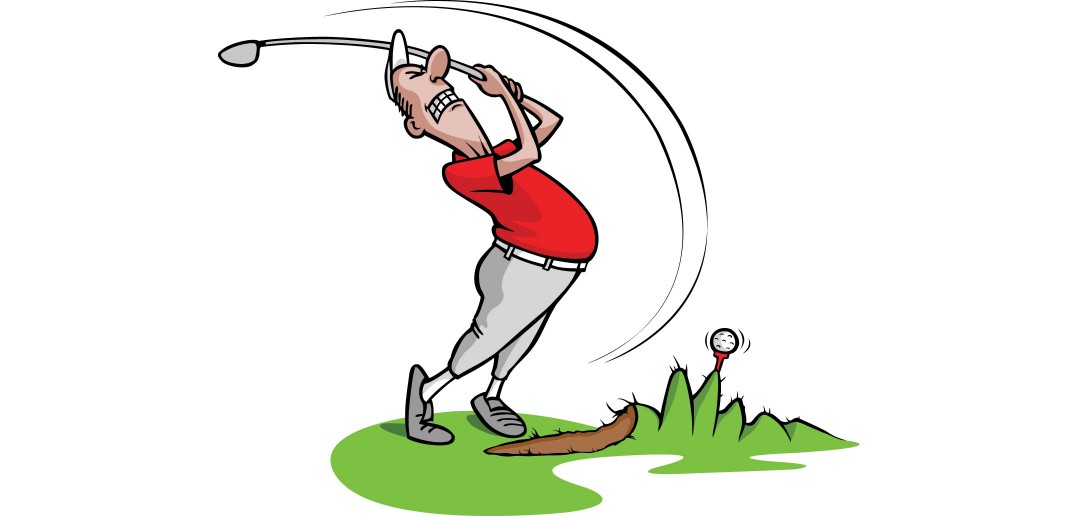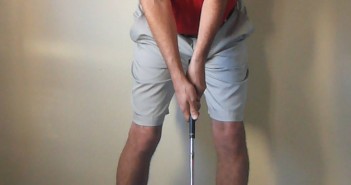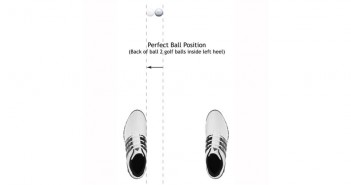This article discusses the reasons why most people struggle with their golf game, and why traditional golf tuition doesn’t work for them.
Where Did it All go Wrong?
If you’re like most golfers, then when you started playing you spent some time on the range, the putting green, maybe even practised chipping if you were really keen. You probably took a lesson or two, and played a few rounds with your friends.
You went from complete novice to being able to negotiate the course, without embarrassing yourself too much, pretty quickly. You got the bug.
So you worked on your skills by driving and putting more balls, playing more rounds.
Your swing became more automatic, less clumsy, you didn’t have to think so hard about the mechanics of each shot. You played using your intuition. “You know what? You could be pretty good at this game!”
Golf was a social outing. You occasionally concentrated on a difficult or important shot, but you realised that you played better when you didn’t think about it too much.
The focussed attention that you needed to apply in order to learn diminished. You reached a plateau in your skill level.
You took tips from your buddies, read some books and magazines, maybe took the odd lesson, but you stayed at basically the same skill level, perhaps for decades.
You didn’t improve because you didn’t have a mechanism for learning. Playing golf is no way to learn how to swing better, hitting one shot from any given location with no way to figure out how to correct your mistakes. And, as we’ll see later, playing golf and learning to swing the golf club better are entirely different, mutually exclusive, activities.
To this day, what little learning you do is about fixing particular flaws, addressing the symptoms, applying Band Aids. Sure, you still go to the range occasionally, but you find yourself mindlessly pounding balls, perhaps tinkering with the latest tips, but it’s really little more than good exercise. Your practice is monotonous, you’re on autopilot, you repeat previously determined goals without giving the swing pattern much planning. Even if you still take lessons, they usually start with you telling your instructor that you’d like to fix a specific problem, address a symptom.
Sure, the guys on tour can do amazing things with a golf ball. But they’re gifted, naturally talented, right? They know “the secret” that no one will tell amateurs, don’t they? If all you had to do all day is play golf then you’d be pretty good too, right? Wrong!
What most golfers just don’t “get” is that the key, the “secret”, to having a great golf swing is proper practice — carefully controlled effort, reflection and analysis. You need to practise the right things, and you need to practise in the right way.
The real secret to playing great golf is knowing how to learn.
Traditional Golf Tuition Doesn’t Work
The average golfer hasn’t improved over the past 50 years. Tour professionals and elite amateurs are hitting the ball further and straighter than ever before — much more than can be accounted for by improvements in equipment — to the extent that many tour venues have had to be toughened up to the point where they are almost unplayable by the average amateur. Yet on your local municipal or member’s course, things haven’t got any tougher but average handicaps haven’t improved.
This is because golf tuition hasn’t addressed the root cause of the problem.
Many instructors teach based on their personal preferences, on what they were taught, on what the hall-of-fame teachers taught, and on what works for them. Their thinking is prehistoric, being based primarily on what their eyes are able to see. Biomechanical science, in conjunction with the latest equipment such as super high speed video cameras, electromyography (EMG), force plates, launch monitors such as TrackMan, and 3D motion capture such as AMM (all of which are used by Golf Loopy), have only recently enabled us to measure and analyse the forces and movements within the golf swing accurately and scientifically. In just the last few years we’ve learned more about the golf swing than was ever known before.
Perhaps even more importantly, we now understand better than ever how people learn new movement patterns, so we’re able to take what we now know about how the body needs to move and translate that into real golf swings.
Traditional golf instruction will tell you what to do, but can’t really explain why (“because Hogan said so” or “that’s what TGM says” just don’t cut it any more), and it’s really terrible at helping you with the “how” — how to move, what muscles to use in what sequence, how to learn that.
The human brain doesn’t learn that way!
As we’ll see next, in How to Learn a Great Golf Swing, learning is a biological process.
Taking a lesson and then going on the range and hitting balls, trying to groove your swing changes, is very ineffective. The human brain doesn’t learn that way.
And it’s not just a terrible way to learn. Hitting golf balls at full speed while practising can be counter-productive and even destructive. There you are, after a good lesson, on the range trying out your new swing change, full of confidence. You’re performing your swing change almost perfectly, but because it’s new you’re naturally a little anxious, you tense up just a tiny amount, you duff one. You know, intellectually, that the bad shot was not due to your swing change, but your intuition starts screaming at you, it hates change, what are you trying to do? Your unconscious self, your inner athlete, will try to save you from yourself. Without you even being aware, it will introduce compensations, you’re swinging too fast to detect them. Now, because of the unconscious compensations, the feeling that your instructor taught you to look for has changed. You’re sure you’re still performing the move correctly, aren’t you? Unwittingly, you tense up some more, you hit some shockers, you’ve not hit the ball this badly for as long as you can remember, it must be the swing change, it’s not working. Suddenly you’re flailing, unsure of yourself, unsure of the feeling you’re looking for. You try to calm yourself down by making a few swings without the new change, but they feel odd too, you’re still tense, you’re playing like a complete hacker. You’re lost.
Even if your practice session goes well, you’ve not worked in a very effective way, you’ve not ingrained the new skill by building the new circuitry in the brain that is necessary to perform a task skilfully and consistently. Any improvement you make will be very slow, and it probably won’t last.
To learn a new skill, to change a movement pattern, or to break a bad habit, the brain needs to build new pathways.
Building and reinforcing these pathways takes time, it needs to be done in small steps, it needs focused, perfect repetition.
You can’t focus in the right way when you’re concentrating on hitting golf balls. You need to build the pathways before you can perform the golf swing at full speed and in distracting situations.
Lies, damned lies, and golf swing theories
Most golf tuition reflects the dominant players of the day – “you should do this because it’s what Tiger/Phil/Rory/Luke does” — and the current fads and theories of the most successful teachers.
At the time of writing, Bubba Watson is doing pretty well, but no instructor in their right mind would teach you to swing like Bubba. Tiger Woods is the most successful golfer of the modern era, but which Tiger swing is best, the one that won most majors, the one that damaged his knee so badly? Jack Nicklaus is considered the greatest golfer of the 20th century, if not ever, but he needed hip replacement surgery, so that can’t be right, surely?
Golf instruction has changed significantly over the years, because almost all of it is not based on objective science, on the black and white fundamentals of anatomy and kinesiology.
There are many thousands of swing gurus, magazines, books, videos, and websites, all vying for your attention, most offering some “secret” that will add 30 yards to your drive or fix your slice.
There are also fads that crop up regularly, trying to offer the improvement-hungry (and gullible) golfing public something new, something different, some hope that this time it will be different. Some of them stick around for a while, they may even gain a cult following. Few of them, if any, take many average hackers and help to turn them into scratch golfers. None of them are used by more than a handful of elite golfers.
The result is a huge amount of misinformation. Even the fairly good stuff is conflicting and is often presented as a seemingly random, inconsistent, often self-contradictory, jumble of tips and drills.
Worst of all, much of it is just plain dangerous. The huge majority of tour players miss months of their careers because they suffer serious golf-related injuries. Yes, they play a lot of golf, but they’re much more efficient than most amateurs. Trying to do what many of them do might seriously hurt you.
It’s no wonder that golfers are frustrated and confused.
Swing plane teaching
Most instructors are obsessed with swing plane and club head path. These things are really important, but this obsession is misguided.
Plane and path are a product of how you move your body, the golf club doesn’t move itself. When you move correctly, the shape of your swing will take care of itself.
Planes and positions are very useful tools for checking that you’re moving correctly. But, as a golfer who wants to learn how to swing better, it’s much more instructive to teach you how to move, which muscles and joints to move and in what sequence, and what that feels like.
Ball flight teaching
Most instructors teach you based on your ball flight. You slice the ball, hook it, hit it too high, too low, you want to turn your high fade into a penetrating draw. The instructor has fixes for each of these, but the fixes mostly address the symptom (the ball flight) and not the root cause (how you are moving your body). The fixes are usually Band Aids — such as “strengthen your grip”, or “close your stance” — and they don’t last. You end up coming back next week, or bouncing from quick fix to quick fix trying to “find it”.
Of course, ball flight is important. It is very important. But ball flight is simple to fix once the proper movement patterns have been established.
Only by learning exactly how to move, using the correct muscles, in the correct sequence, will you make lasting change and improvement.
It’s also important to realise that most instructors are just plain mistaken in their beliefs about the mechanics of ball flight, specifically what happens at impact to cause a particular shot shape. What was accepted as truth just a few years ago has now been proven to be very wrong — largely due to recent developments in launch monitors, such as TrackMan. We’ll discuss the real laws of ball flight, in detail, in later articles.
Impact teaching
Impact, the moment of truth. Everything else in the golf swing is incidental. All that really counts is your impact dynamics as the golf club approaches, contacts, then swings through the ball. Right?
Impact teachers will tell you that by focussing on creating perfect impact dynamics — hitting down on the ball with a forward-leaning shaft, hitting through the ball, taking the correct divot — you will become a great ball striker, that the rest of the swing will take care of itself.
Impact is certainly the most important part of the golf swing. But the dynamics of the rest of the swing, far from being incidental, directly contribute to your success or failure at the moment of impact.
Most importantly, it is possible to have perfect impact dynamics with a variety of swings. It is possible to have perfect impact dynamics with a swing that is inconsistent, with a swing that won’t always hold up under pressure, or with a swing that won’t enable you to hit a variety of shots in different conditions.
Oh, and the one that impact teachers always seem to forget, it is possible to have perfect impact dynamics with a swing that will hurt you!
Quick Fixes Do Not Work
Tips and quick fixes just don’t work. Most modern golf tuition is based on addressing symptoms, like fixing a slice. Most modern golf tuition is dead wrong.
Your brain doesn’t learn that way. When you stop to think about it, you’ve never learned anything meaningful that way.
The quick fix may well fix the symptom, at least temporarily. That’s great, losing balls out of bounds on the right can get pretty boring, pretty quickly!
Unfortunately, the quick fix is insidious, and it will damage your game. It encourages (forces) you to keep practising the faulty movement pattern at the heart of the problem, ingraining it deeper and deeper. It introduces further compensations into your swing, compounding the problem. It will make it harder, much harder, to ever be really good at golf.
Many teachers will offer a fix based on a feeling. “You’re doing X wrong, when you do it right it will feel more like Y.” This is great, in the short term. But it only feels the way it does because you have a specific set of flaws and compensations in your swing at that moment in time. As your swing changes, you still keep looking for the same feeling, you probably start overdoing it, introducing new compensations. Before long you’re just chasing your tail.
Only by learning how to move correctly, from the ground up, can you make significant and lasting improvements. Establishing the correct movement pattern will quickly, easily and permanently fix swing issues such as slicing the ball.
And once again, trying to implement a quick fix while not addressing the underlying problems will cause you to move your body inefficiently, further compounding problems and risking injury. Injuries plague the world of golf at all levels because of poor instruction and the quick fix mentality.
Instant Gratification
Most golfers are relatively cash rich and time poor. Many are successful people off the golf course, and they are used to getting their own way, used to getting results, used to being good at stuff.
They would rather spend $400 on a new driver that promises instant results, than invest their valuable time and effort into a structured learning process.
They forget, or don’t realise, just how much hard work it took to learn the skills that they already have. Maybe they were highly motivated, driven, or did it for the love of it. Maybe it seemed to come easy to them. But, one way or another, they put in hundreds, maybe thousands of hours of practice.
Perhaps because they underestimate the power of proper practice, they find it easier to accept the myth of natural talent. “Those guys on tour were born with it, it was easy for them, look at how effortlessly my club champion strikes the ball, I wish I was gifted like that.” Natural talent is indeed a myth, talent is learned, not gifted, but believing the myth makes it easier to dismiss the fact that you don’t work as hard, or as effectively, as the other guy.
Golf Digest once called Sam Snead “the best natural player ever”. Sam Snead said “People always said I had a natural swing. They thought I wasn’t a hard worker. But when I was young, I’d play and practise all day, then practise more at night by my car’s headlights. My hands bled. Nobody worked harder at golf than I did.”
Most golfers also forget just how much fun, and how rewarding, learning can be.
You are Not the Problem
Many golfers have been told, or otherwise come to believe, that they are not flexible enough, they’re not a natural athlete, they’re too old…
This is just plain wrong. Any golfer of any age with any level of “natural” ability can learn to swing the golf club correctly and strike the ball beautifully.
The golf swing is a complicated movement pattern, but it can be easily learned if you approach it in the right way.
So Why Aren’t You a Great Golfer?
Simply because you’ve not had the right information, communicated to you in the right way, explaining not just what you need to do but how to do it. And you’ve not been given an effective learning program, designed around the way that your brain works.
The Golf Loopy Swing like a Champion system takes you beyond simply understanding technique, to quickly building and ingraining a great golf swing. It’s not a fad or just another swing theory, it’s based purely on objective science. It’s not a collection of tips and fixes, it’s a complete learning system, based on the latest scientific understanding of how people learn new movement patterns.
If you have any questions or comments about this or other articles on Golf Loopy, please send us an email.
Next, a look at how the brain learns new skills, and how you can use that to accelerate your learning, in How to Learn a Great Golf Swing.




